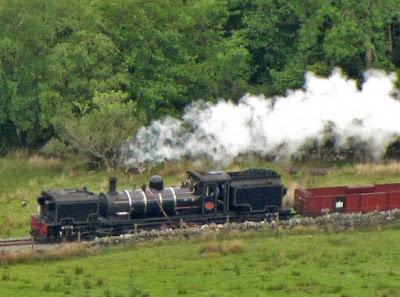The Great Orme Tramway, a vintage tram system (built 1902), conveys visitors to the summit of the Great Orme a prominent limestone headland on the north coast of Wales north of Llandudno.
From the summit 207m (679 ft) there are excellent views back to the mainland as here beyond Deganwy and across the Afon Conwy to Conwy itself.
Also across Bae Conwy to the mountains of north west Wales.
The Great Orme Mines are possibly the most important copper mines of the Bronze Age yet discovered and excavated. Apparently abandoned around 600 BC, but with some evidence of Roman patronage, the mines were reopened in 1692 and continued to be worked until the end of the 19th century. Then buried in waste rock from local quarries, they were re-discovered in 1987 when the waste tips were in the process of being landscaped.
The narrow and cramped underground workings on 2 of the 16 levels can be explored.
On Thursday we began our walk in the village of Abergwyngregyn and climbed rapidly to pick up the trail through the Afon Anafon valley.
Abandoned stone walled sheep folds are quite common in this part of Wales especially on level terraces close to water.
At the head of the valley there was a steep climb to the top of Foel Fras 942m (3,091 ft). Although the approaches to these mountains are quite grassy the summits were always boulder strewn with sizeable frost shattered blocks of rock.
The top of Garnedd Uchaf 926m (3,038 ft) was similar.
The view south from the top of Garnedd Uchaf . I can’t remember the names of the main peaks.
During the descent we witnessed a helicopter rescue from the sheepfold on Gyrn.
Crossing the Afon Rhaeadr bach high above the valley floor, we took the opportunity cool ourselves with a hat full of cold water.
Aber Falls from the slopes of Moel Wnion.
Before descending to sea level once again we could glance back over the latter part of our route for today. 12 miles, 3325 ft of ascent and about 7 hours with stops.
Final posting covering the last day - to come. Watch this space.


































